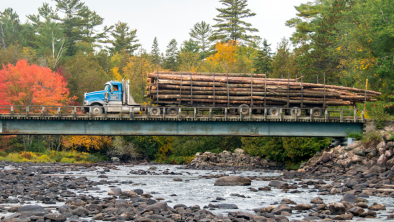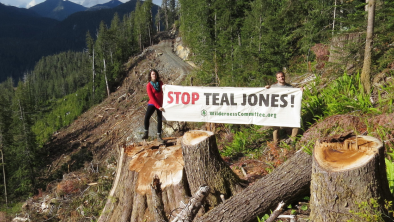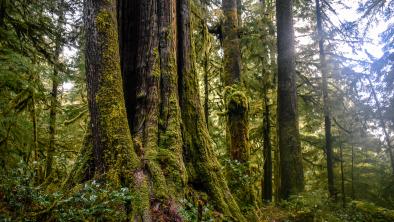B.C. moose ravaged by salvage logging of beetle-killed pine forests
Sunday, July 22, 2012
Vancouver Sun

Aggressive drive on pine-beetle killed timber blamed as habitat left exposed and numbers plunge by up to 70 per cent
Aggressive salvage logging of beetle-killed pine forests is being blamed for moose populations crashing by up to 70 per cent in the B.C. Interior.
Massive clearcuts with no size limits have eliminated extensive habitat, leaving moose exposed and vulnerable to human hunters and wild predators that are taking advantage of increased access to the back country.
The situation is so serious that the province is imposing greater restrictions on hunting opportunities, and one aboriginal group is declaring their traditional Chilcotin territory off-limits to non-native moose hunters this fall.
Surveys by the Ministry of Forests, Lands and Natural Resource Operations over the past two winters have discovered serious declines in moose populations, amounting to:
• 70 per cent since 1997 in the 5,000-square-kilometre Nass Wildlife Area near Terrace.
• 60 per cent in the Anahim Lake/Dean River area and 17 per cent decline in the Rose Lake-Miocene area, both in Cariboo region.
• 50 per cent since 2005 around Prince George.
• 20 per cent since 2004 in the Bulkley Valley-Lakes District in west-central B.C.
A ministry document dated May 2012 states that “all possibilities for the decline will be investigated,” including “unregulated hunting, increased access, predator populations, changing environmental conditions (including habitat changes resulting from the mountain pine beetle infestation and timber salvaging), and cumulative impacts of one or more of these factors.”
Rodger Stewart, the ministry’s director of resource management for the Cariboo region, said in an interview that he expects a qualified professional to be contracted to work with government staff to produce a report on the issue in three to four months.
He said the province isn’t jumping to conclusions, and wants to better appreciate how land-use activities such as salvage logging and predation by humans and wild animals impact the moose, and how best to reverse the situation.
“We have several factors at play and we want to know which has the greatest weight,” he said, adding that even without salvage logging, major forest fires have altered the landscape and made it easier for predators to spot moose.
The hunting community is quick to confirm salvage logging’s considerable influence on the landscape.
Al Martin, a consultant with the 40,000-member BC Wildlife Federation, said the province has allowed large-scale salvage logging to proceed for years with little thought to the environmental consequences.
“Clearly, salvage logging was the main driver in the mountain pine beetle initiative,” Martin said in an interview. “There was little attention paid to the effect of accessing all this timber from an ecological perspective and economic perspective.”
While moose have expanded their range in B.C. (due to logging producing more forage habitat) over the last century, the current scale of salvage logging in the Interior is so vast that it is working against moose populations, he said.
“Those large openings — and access — make moose more vulnerable to hunting pressures and predators,” he said. “They are forced into smaller and smaller islands of habitat.”
The Forest and Range Practices Act, introduced in 2004, limited the size of individual clearcuts to 60 hectares in the Interior.
But that limit does not apply to salvage harvesting, which has no upper-size limits.
Independent watchdog, the Forest Practices Board, has documented the scale of salvage logging in the Interior, noting that some amalgams of harvested areas exceed 10,000 hectares — that’s an area 25 times the size of Stanley Park.
Martin said that moose are a highly sought-after big-game animal in the Interior, with applications for limited-entry hunts in some areas of the province outnumbering opportunities by a 10-to-1 ratio.
Despite such interest among hunters, he said, the province has failed to provide the sort of ongoing inventories necessary to monitor declines in moose populations at an early stage.
Martin urged resident hunters, guide-outfitters, and aboriginal hunters to work together to achieve recovery of moose populations as quickly as possible, with culls of predators one option.
The B.C. government has already declared open season on wolves in the Cariboo region, lifting closed-season and bag-limit restrictions in 10 management units. The province has also liberalized trapping requirements in the region.
Scott Ellis, executive director of the Guide Outfitters Association of British Columbia, called for a comprehensive provincial plan that includes consideration of all measures, including reducing both the number of access roads and the hunting of moose cows and calves.
“Quite frankly, I think all parties are concerned,” he said, noting non-residents pay about $7,000 for a guided moose hunt.
Ellis said lodgepole pine forests provide greater warmth in winter and feature less snow than clearcuts, while affording moose cover from predators. “It’s the amount of logging that makes the difference,” he said. “You’ve got huge blocks of lands logged for miles. Moose are big and stick out like a sore thumb. When they go through it, any predator can figure out how to cut them off.”
The Tl’etinqox-t’in First Nation has declared moose hunting off-limits to hunters who are not Chilcotin aboriginals in their traditional territory north of Alexis Creek. In a news release the first nation said members are “gravely concerned” that moose populations and habitat are being compromised by excessive timber harvesting.
The Vancouver Sun published a five-part series in December 2011 on the environmental impact of salvage logging of lodgepole pine forests killed by the mountain pine beetle.
At the time, the province’s chief forester Jim Snetsinger dismissed concerns about the impact of salvage logging on wildlife, noting he spotted moose and wolves during a recent stay at a rustic lodge in the Chilcotin.
“The ecosystem isn’t dead out there,” he insisted. “If there are wolves, there’s moose and deer. That’s a microcosm, but I got a good sense that things aren’t so bad out there. We have a resilient ecosystem.”


